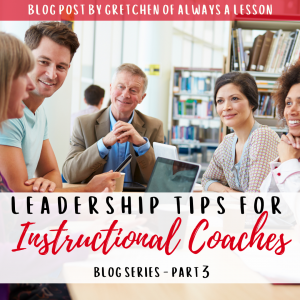Leadership Tips for Instructional Coaches- Part 3
This four-part series shares leadership tips for instructional coaches. Each subsequent post will be specific to an aspect of coaching. Part One shared generalized tips. Part Two discussed organization, professional growth, and teacher motivation/buy-in. This blog post is Part Three and discusses how to best support classroom instruction.
The role of an instructional coach is to grow and develop teachers so that students achieve success in the classroom. There are many ways to support instruction, but 10 best practices are shared below:
 Learning Strategies for the Teacher
Learning Strategies for the Teacher
- Bite Size Tips– Avoid overwhelming teachers with a long to-do list. Share small action steps they can implement to become more successful in the classroom. Keeping it simple with easy-to-implement steps ensures teachers feel successful faster.
- Data Wall– Make a habit of tracking student achievement data. This can be done individually in a notebook or online spreadsheet or by grade level on a bulletin board in the planning room. Mark student data with a numerical system instead of names to protect confidentiality. Teachers should use this data to plan instructional supports for their upcoming lessons. They should also mark any changes in the data so that they are always making informed decisions based on current data. These Data Tracking Sheets will be helpful for teachers.
- Follow Up– Teachers are busy, but it doesn’t mean you should let their action steps slide. Follow up with them to ensure they implemented their next steps and make note of how well they did so. Their improvement will skyrocket if you follow up with additional feedback after they implement the original suggestions.
- Learning Walk– Allow teachers to grow and learn from each other. Set up a system where teachers can observe their peers teaching students live. They can walk into a handful of classrooms for 10 minutes to see a snapshot of instructional best practices. It is helpful to see a variety of teaching styles demonstrating strong instructional strategies to the same student population within the same school building. It is the strongest mimic strategy to improve teacher proficiency. This packet will help you make learning walks successful in your building.
- PD with a Purpose– Provide learning opportunities to teachers that are meaningful. PD topics should align to state, district and school goals. They should compliment any current initiatives being implemented. PD topics should also meet the needs or wants of teachers. This ensures the learning time is well spent in an area that is important. (Don’t forget to add in time for teachers to practice their new knowledge to increase the likelihood it will be implemented into the classroom.) This PD course will help you plan and lead an inspiring PD session.
Leadership Strategies for the Coach
- Co-Teach– Helping teachers teach more effectively live in front of students can be powerful. Co-plan a lesson, decide who will teach what part, hone in on an aspect you will be demonstrating, and then teach together in front of students. Seeing a technique implemented live in front of actual students helps the teacher visualize what it will look like when they give it a try on their own later.
- Follow Through– A powerful way to build trust is to mean what you say and say what you mean. If you promise to do something for someone, be sure to follow through. When you repeatedly follow through on your commitments, you become reliable, dependable and trustworthy. This builds strong long-lasting relationships with teachers.
- Model, Ask, Expect- Follow a simple 3 step process when working with teachers. Model the expectation. Ask teachers to practice it in a mock setting with peers. Then, expect them to replicate it in their own classrooms. Repeat this process with any new expectation required of teachers.
- Observe with a Purpose– When going into classrooms to observe, choose your focus ahead of time and only take notes and provide feedback on that one area. Overwhelming yourself with all aspects of instruction will cloud the clarity of your feedback and derail the progress in the focus area. A good note taking guide will help you stay focused.
- Turn Problems into Action Steps– Help teachers overcome obstacles by asking questions to determine the root of the problem. Then, instead of allowing teachers to vent and complain about the problem, swiftly move the conversation into problem-solving mode. Together, create action steps to overcome the obstacle. This is an efficient use of time, keeps the conversation on track, and translates into teacher improvement instead of teacher dissatisfaction.
NEXT STEPS
- Continue to follow this blog series for more leadership tips for instructional coaches (Read Part One & Part 2).
- If you’d like to dig in on a deeper level, you can gain professional development (and credit towards your teaching license) through the “Teachers Who Lead” course bundle.
- Get access to more instructional coaching resources and professional development resources below:
Go Be Great!
What leadership advice do you have for instructional coaches?
← Leadership Tips for Instructional Coaches- Part 2Leadership Tips for Instructional Coaches- Part 4 →



